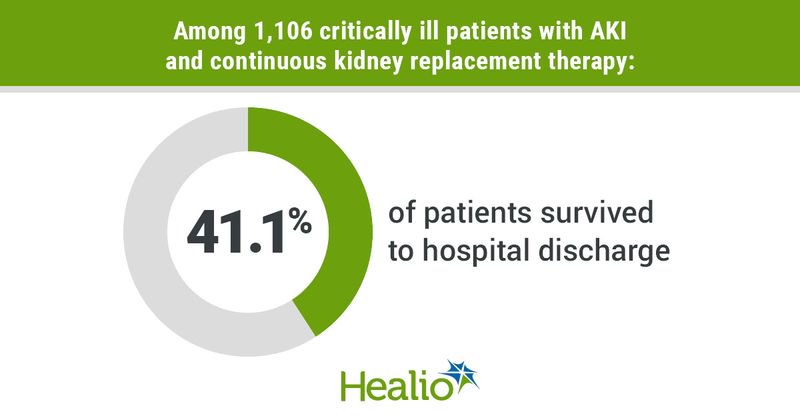Fluid management indicates continuous kidney replacement therapy initiation
Key takeaways:
- Sepsis was a major contributor to AKI.
- Fluid management serves as the main indicator of continuous kidney replacement therapy initiation.
An exploration of a registry of patients undergoing continuous kidney replacement therapy revealed fluid management is a main indicator that a patient will initiate the therapy, according to data published in Kidney Medicine.
“Continuous kidney replacement therapy (CKRT) is frequently utilized in intensive care units (ICU). However, we do not know what type of patients are usually started on CKRT, how CKRT is prescribed, nor what usually happens to patients who had CKRT. The CRRTnet Registry has created a database of such patients that outlines these characteristics,” Oleksa G. Rewa, MD, MSc, from the department of critical care medicine and faculty of medicine and dentistry at the University of Alberta, and Alberta Health Services, and colleagues wrote. They added, “Information determined from this registry can assist with future work of establishing targets for CKRT delivery, performance and outcomes to improve the quality of care received by these vulnerable patients.”

In a prospective, multinational, multicenter, observational and ongoing study, researchers examined 1,106 critically ill patients with AKI and CKRT between December 2013 and January 2021. Researchers collected demographic data from patients at ICU admission and the start of CKRT.
With CKRT for longer than 24 hours serving as the exposure, researchers considered survival at hospital discharge the primary outcome. Secondary outcomes included kidney recovery and health care resource utilization.
Using a chi-square test and t-test, researchers conducted two-group comparisons of clinical characteristics according to hospital mortality. Additionally, researchers performed a multivariable logistic regression model to develop a mortality probability to calculate standardized mortality ratio for each study site based on what parameters differed in patients who died vs. those who survived.
During the study, 41.1% of patients survived. Patients who died were older, had greater comorbidity and a higher acuity of illness. Analyses revealed sepsis predisposed 42.6% of AKI cases. Further, oliguria/anuria indicated 56.2% of CKRT cases. This was followed by fluid overload, which indicated 53.9% of cases.
“Interestingly, while the precise CKRT prescription and delivery differed amongst sites, this did not translate to statistically significant different standardized mortality ratios. This may reflect the fact that outcomes of patients undergoing CKRT may be in part related to having CKRT performed at experienced high-volume centers with extensive expertise and available logistics for the provision of CKRT, rather than specific factors associated with the CKRT prescription,” Rewa and colleagues wrote. “Importantly, additional data will be needed to compare provision of CKRT and patient outcomes between large academic centers and smaller, lower-volume community centers. However, registries like CRRTnet can assess concordance (or lack thereof) with current guidelines and identify discordant practices and opportunities for continuous improvement.”
